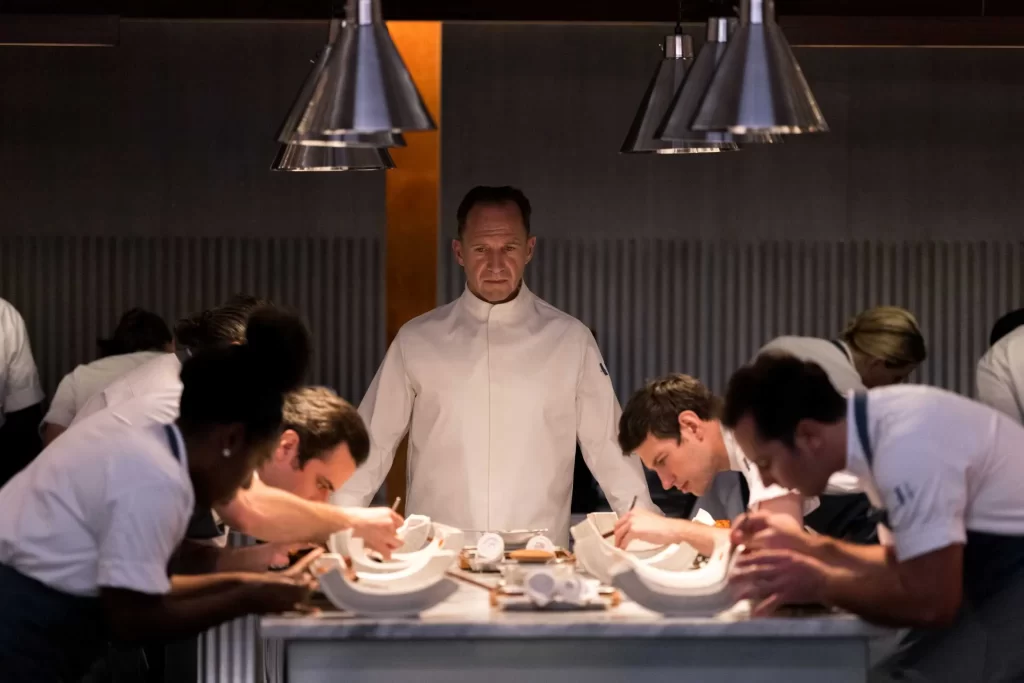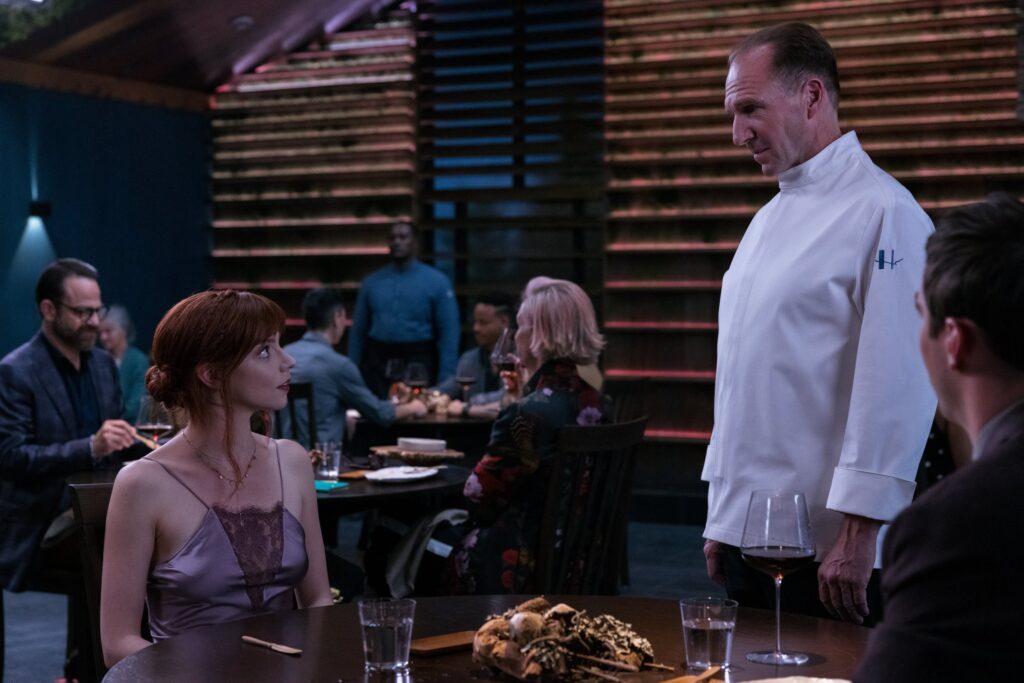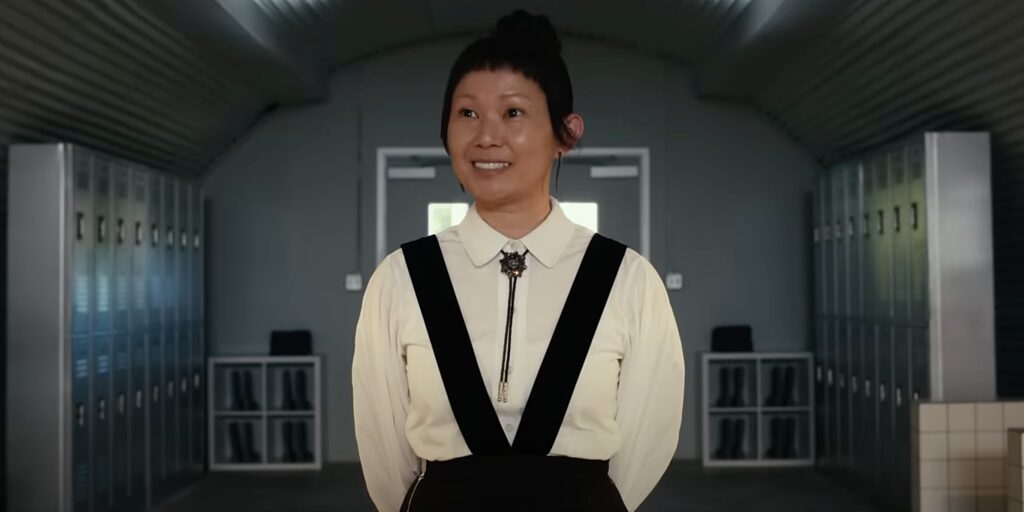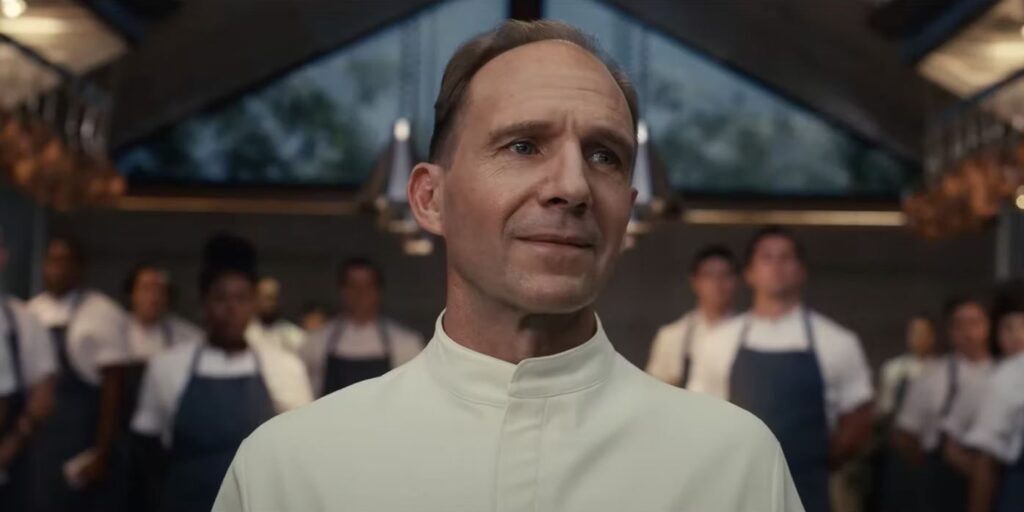
Nobody technically eats the rich in The Menu, even if a few splinters of bone marrow make their way onto some dinner plates. But the movie, which was directed by Mark Mylod from a script by Seth Reiss and Will Tracy, plainly has an appetite for first-world destruction. This makes it a familiar dish—a sizzling satire of upper-crust vulgarity whose recent forebears include the hide-and-seek thriller Ready or Not and the yachting misadventure Triangle of Sadness. Yet while The Menu may be rooted in a recognizable recipe, it nevertheless mixes its customary ingredients with shrewdness and flair. It doesn’t introduce new flavors to your palette, but it’s plenty tasty all the same.
If these metaphors seem indecent, just wait until you meet the movie’s characters. The opening act introduces a coterie of pompous oafs, all of whom have paid an outrageous fee to travel by boat and dine at an exclusive island restaurant called Hawthorn. They include a pretentious food critic (Janet McTeer) and her sycophantic editor (Paul Adelstein), a has-been actor (John Leguizamo) and his exasperated assistant (Aimee Carrero), three insufferable finance bros (Rob Yang, Mark St. Cyr, and Arturo Castro) who surely would’ve founded FTX if only they’d had the chance, an elderly couple (Reed Birney and Judith Light) who are among the establishment’s most loyal regulars, and a foodie named Tyler (Nicholas Hoult) who slurps oysters with the zeal of a child opening Christmas gifts. Fatted lambs who just may be buying a ticket for their own proverbial slaughter, these snobs carry themselves with an air of entitlement that instantly make them unsympathetic—creatures of obscene privilege and even greater self-regard.

Except, that is, for Tyler’s girlfriend, Margot (Anya Taylor-Joy), a more down-to-earth sort who regards her new companions and surroundings with wariness and skepticism. She’s met with a commensurately frosty reception by Hawthorn’s maître d’ (Hong Chau), along with its head chef, Julian (a perfectly crisp Ralph Fiennes), who’s a piece of work in his own right. He may simply cook food, but Julian’s authoritative bearing suggests the supremacy of a monarch, or maybe a military general. Before serving each course, he brings his hands together with a thunderous clap, and his staff instantly straighten up as though their commandant has just ordered them to march into battle.
Which, in a way, he has. The central conceit of The Menu—beyond the allure of Hawthorn itself, which the production design (by Ethan Tobman) renders as both enchanting and threatening—is its vision of a society that comprises two castes: the masters and the servants. Despite their foibles—we hear murmurs of infidelity, embezzlement, and tax fraud—the guests attending this exclusive eatery surely wouldn’t call themselves bad people. It’s more that they exist in a universe that’s entirely separate from the world inhabited by the employees and underlings whose labor they casually, mindlessly exploit. The movie’s suspense derives from its gradual reveal of Julian’s elaborate efforts to restore power to the working class— to turn the dinner tables, as it were—along with our uncertainty about which tribe Margot belongs to.

Again, this notion of haves and have-nots—and the corresponding concept of the latter enacting vengeance on the former—is hardly novel; it’s been more than a century since H.G. Wells concocted child-snatching Morlocks in The Time Machine. As a result, any putative sharpness to the satire on display here is dulled by the sensation of familiarity. Yet what’s refreshing about The Menu is that, despite its rather obvious sociopolitical agenda, it doesn’t strain for thematic profundity. Its points may be blunt, but it executes them with a smooth style that’s playful, impish, fun.
“Don’t eat,” Julian admonishes his ravenous customers. “Taste.” And it’s evident how much pleasure Mylod and his cast have taken in making this slick, silly movie. Straight from the opening title card (“Searchlight Pictures invites you to experience The Menu”), the film plants its tongue firmly in its cheek; its textual mischievousness continues throughout with on-screen descriptions of Julian’s dishes, which quietly jab at the restaurant industry’s grandiosity. (When one course turns sour, we learn that it features “utter lack of cohesion.”) There are bread plates without bread, scissors protruding from chicken thighs, and tortillas that double as incriminating photographs. It’s all ludicrous, and delightful.

Narratively, the overall arc of The Menu may be preordained (just watch the trailer, though honestly, don’t), but the script still manages to sprinkle in spicy dashes of unpredictability. A sous-chef’s mournful confession concludes with a shocking jolt; a short-wave radio becomes an instrument of potential salvation. And while an attempt to integrate the #MeToo movement feels somewhat shoehorned, it also adds an intriguing wrinkle, suggesting that the servile characters must wrestle with divisions of their own.
The actors, on the other hand, are uniformly excellent. The supporting cast is precisely calibrated, in particular Hoult’s obsequiousness and Chau’s lethality. But the main attraction here is the simmering conflict between Julian and Margot, and the contrasting styles of the two leads. By his mere presence, Fiennes exudes patrician superiority, and it’s wonderful to watch him channel that arrogance into barely suppressed anger. (He mostly operates at a haughty chill, which is why it’s so marvelous when he suddenly bellows, “There are no substitutions at Hawthorn!”) For her part, Taylor-Joy—flashing auburn hair, and decked out in an incredible lavender dress—doesn’t try to match her costar’s fearsomeness, instead emphasizing Margot’s cagey intelligence; she attracts our sympathy even as we question her true intentions.

What’s perhaps most impressive about The Menu is that it manages to sustain its peculiar atmosphere—a frothy cocktail of dry humor, incipient terror, and arch satire—for its entire running time. Its only lapse lies in a perfunctory fight scene that mistakes motion for excitement, and which exposes Mylod’s limitations as a filmmaker. (Otherwise, the chief director of Succession proves a natural fit for this material; it’s easy to imagine the Roy clan routinely dining at Hawthorn, then getting blackmailed by the staff.) Where most pictures of its ilk inevitably devolve into shrill action heroics, the climax here is instead an exhilarating battle of wits, wordplay, and—of course—cooking.
The Menu is so robustly enjoyable—so exquisitely prepared and served—it’s easy to overlook how ridiculous it is. But is its absurdity a storytelling flaw, or an allegorical argument? I’m not sure it matters. It’s best not to take the movie too seriously—or rather, to appreciate how seriously it goes about its primary business of entertaining its audience. As Julian might advise: Don’t watch. Savor.
Grade: B
Jeremy Beck is the editor-in-chief of MovieManifesto. He watches more movies and television than he probably should.
